The ARM vs x86 Wars Have Begun: In-Depth Power Analysis of Atom, Krait & Cortex A15
by Anand Lal Shimpi on January 4, 2013 7:32 AM EST- Posted in
- Tablets
- Intel
- Samsung
- Arm
- Cortex A15
- Smartphones
- Mobile
- SoCs
SunSpider 0.9.1
The results get more interesting when we look at power consumption during active workloads. We'll start off with SunSpider, a mid-length JavaScript benchmark that we frequently use in our reviews:
At the platform level, Qualcomm's APQ8060 powered Dell XPS 10 falls in between Surface RT and Acer's W510. Active power looks very similar to the Intel powered W510, but performance is appreciably slower so total energy consumed is higher.
Looking at the CPU, the situation changes a bit. Intel's peak power consumption is similar to Tegra 3, while Krait manages to come in appreciably lower. I suspect that missing the L2 cache power island here is lowering Qualcomm's power consumption by 100 - 200mW but overall CPU-only power consumption would still be lower. Once again, at idle Krait seems to have a bit of an advantage as well.
The situation changes once we look at GPU power consumption, with Intel/Imagination having the clear advantage here.

Kraken
Mozilla's Kraken benchmark is a new addition to our js performance suite, and it's a beast. The test runs for much longer than SunSpider, but largely tells a similar story:
At the platform level, Acer's W510 has slightly higher peak power consumption compared to the Dell XPS 10 but it also completes the test quicker, giving it a better overall energy usage profile.
Looking at the CPU cores themselves, Qualcomm holds onto its lead here although once again, I suspect the margin of victory is exaggerated by the fact that we're not taking into account L2 power consumption for Qualcomm. Intel does deliver better performance, which allows the CPU to race to sleep quicker than on APQ8060A.
The comparison to Tegra 3 is not surprising, this is exactly what we've seen play out in our battery life tests as well.

RIABench
RIABench's Focus Tests are on the other end of the spectrum, and take a matter of seconds to complete. What we get in turn is a more granular look at power consumption:
Here the W510 consumes more power at the platform level, but drops to a lower idle state than the XPS 10. Surface RT clearly uses more power than both.
Krait's CPU level (excluding L2 cache) power consumption is once again lower than Atom's, but Atom completes the task quicker. In this case total energy usage is still in Qualcomm's favor. The fact that there's a discrepancy between CPU specific power results and the total platform results are partly due to the missing L2 cache power consumption data from the CPU power chart for Qualcomm, and partly due to differences in the tablets themselves.




















140 Comments
View All Comments
kyuu - Friday, January 4, 2013 - link
You're the one stepping into the past with the CISC vs. RISC. x86 is not going to go away anytime soon. Keep dreaming, though.iwod - Saturday, January 5, 2013 - link
Nothing about Architectures in this comment, but by the time ARM Cortex A57 is out, so is Intel ValleyView, which doubles the performance. A57 is expected to give in best case scenario 30 - 50% increase in performance. And All of a sudden this look so similar to 2x Atom performance.It will only take one, just ONE mistake that ARM make for Intel to possibly wipe them off the map.
Although looking into the next 3 - 5 years ahead. It will be a bloody battle instead.
Cold Fussion - Friday, January 4, 2013 - link
Why didn't have any charts which were performance per watt or energy consumption vs performance in the GPU area? If the Mali chip is using twice the energy but giving 3x the performance then that is a very significant point thats being misrepresented.mrdude - Friday, January 4, 2013 - link
I was thinking the same thing.If I can game at native resolution on a Nexus 10 at better frame rates than on the Atom or Snapdragon SoC and the battery capacity is larger and the price of the device is equal, then do I really care about the battery life?
Although it's nice seeing Intel is getting x86 down to a competitive level with ARM, the most astonishing thing that I took away from that review was just how amazing that MaliT604 GPU is. All that performance and only that power draw? Yesplz :P
parkpy - Friday, January 4, 2013 - link
i've learned so much from AT's review of the iPhone5, Galaxy S III, and Nexus 4, and this article about mobile phones that it makes me wish AT could produce MORE reviews of mobile devices.All of this information is crack! I can't get enough of it. Keep up the good work! And Intel, I can't wait for you to get your baseband processor situation sorted out!
I was already tempted to get a Razr I, but it looks like before the end of the year consumers will have some very awesome technology in their phones that won't require as much time on the battery charger!
This Guy - Friday, January 4, 2013 - link
What if Rosepoint is software defined instead of fixed function?ddriver - Friday, January 4, 2013 - link
I am confused here - this review shows the atom to be somewhat faster than A15, while the review at phoronix shows the A15 destroying the atom, despite the fact intel's compiler is incredibly good at optimizations and incomparably more mature.So I am in a dilemma on who to trust - a website that is known to be generously sponsored by intel or a website that is heavily focused on open source.
What do you think?
kyuu - Friday, January 4, 2013 - link
Uh, did we read the same article? Where does it show the Atom being "somewhat faster than A15"? The article showed that the A15 is faster than Atom, but at a large power premium.ddriver - Friday, January 4, 2013 - link
On the charts I see the blue line ending its task first and taking less time, blue is atom, right?jwcalla - Friday, January 4, 2013 - link
A couple things:1) The Phoronix benchmarks were for different Atoms than the one used in this article. I don't know how they compare, but they're probably older models.
2) The Phoronix benchmarks used GCC 4.6 across the board. Yes, in general GCC will have better optimizations for x86, but we don't know anything (unless I missed it) about which compilers were used here. If this was an Intel sample sent to Anand, I'm sure they compiled the software stack with one of their own proprietary Intel compilers. Or perhaps it is the MS compiler, which no doubt has decades of x86 optimizations built in and probably less ARM work than GCC (for the RT comparison).
Don't take the benchmarks too seriously, especially since even the software isn't held constant here like it was in the Phoronix benchmarks. It's all ballpark information. Atom is competitive with ARMv7 architectures -- that's the takeaway.